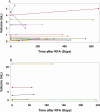Safety and Efficacy of Radiofrequency Ablation of Thyroid Nodules-Expanding Treatment Options in the United States
- PMID: 34258495
- PMCID: PMC8271212
- DOI: 10.1210/jendso/bvab110
Safety and Efficacy of Radiofrequency Ablation of Thyroid Nodules-Expanding Treatment Options in the United States
Abstract
Context: Radiofrequency ablation (RFA) has only recently gained popularity in the United States for treatment of thyroid nodules (TNs), with a limited number of patients having undergone the procedure in this country.
Objective: To evaluate the safety and efficacy of RFA of TNs performed in an outpatient setting in the United States.
Methods: This is a retrospective, single-center study of 53 patients who underwent RFA of 58 TNs between November 2018 and January 2021. The reduction in volume of nodule, cosmetic and symptomatic improvement, effect on thyroid function, and complications following RFA were assessed.
Results: Eleven out of 53 patients were excluded from the analysis. A total of 47 benign TNs (23 nonfunctioning thyroid nodules [NFTNs] and 24 autonomously functioning thyroid nodules [AFTNs]), were assessed after RFA. The median reduction in volume was 70.8% after a median follow-up period of 109 days, with symptomatic and cosmetic improvement (P < 0.0001). Compared with larger nodules, smaller nodules had greater volume reduction (P = 0.0266). RFA improved thyrotropin (TSH) in AFTNs (P value = 0.0015) and did not affect TSH in NFTNs (P value = 0.23). There were no major complications; however, 1 patient had self-limited local bleeding and another had transient voice change that recovered in 6 months.
Conclusion: RFA is a safe and efficacious treatment for symptomatic NFTNs and AFTNs in our population and is especially effective for smaller nodules. RFA should be considered an alternative for TNs in patients who cannot or do not want to undergo surgery.
Keywords: autonomously functioning thyroid nodule; radiofrequency ablation; thyroid nodules.
© The Author(s) 2021. Published by Oxford University Press on behalf of the Endocrine Society.
Figures




References
-
- Kant R, Davis A, Verma V. Thyroid nodules: advances in evaluation and management. Am Fam Physician. 2020;102(5):298-304. - PubMed
-
- Haugen BR, Alexander EK, Bible KC, et al. 2015 American Thyroid Association management guidelines for adult patients with thyroid nodules and differentiated thyroid cancer: the American Thyroid Association guidelines task force on thyroid nodules and differentiated thyroid cancer. Thyroid. 2016;26(1):1-133. - PMC - PubMed
-
- Durante C, Costante G, Lucisano G, et al. The natural history of benign thyroid nodules. JAMA. 2015;313(9):926-935. - PubMed
-
- Durante C, Grani G, Lamartina L, Filetti S, Mandel SJ, Cooper DS. The diagnosis and management of thyroid nodules: a review. JAMA. 2018;319(9):914-924. - PubMed
-
- Chami R, Moreno-Reyes R, Corvilain B. TSH measurement is not an appropriate screening test for autonomous functioning thyroid nodules: a retrospective study of 368 patients. Eur J Endocrinol. 2014;170(4):593-599. - PubMed
LinkOut - more resources
Full Text Sources
